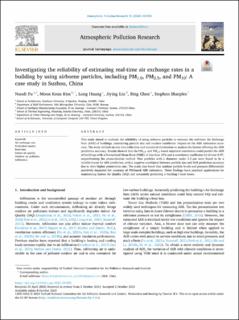Investigating the reliability of estimating real-time air exchange rates in a building by using airborne particles, including PM1.0, PM2.5, and PM10: A case study in Suzhou, China
Peer reviewed, Journal article
Published version
Permanent lenke
https://hdl.handle.net/11250/3098200Utgivelsesdato
2024Metadata
Vis full innførselSamlinger
Originalversjon
https://doi.org/10.1016/j.apr.2023.101955Sammendrag
This study aimed to evaluate the reliability of using airborne particles to estimate the real-time Air Exchange
Rate (AER) of buildings, considering particle size and outdoor conditions’ impact on the AER estimation accu-
racy. The study utilized on-site data collection and numerical simulations to analyze the factors affecting the AER
prediction accuracy. Results showed that the PM1.0- and PM2.5-based empirical correlation could predict the AER
of buildings with a Normalized Mean Error (NME) of less than 10% and a correlation coefficient (r) of over 0.97,
outperforming the pressurization method. Fine particles with a diameter under 2.5 μm were found to be a
reliable tracer for AER prediction, with a negative correlation between particle size and AER prediction accuracy
due to their higher penetration rate. The study also found that outdoor particle levels and pressure differentials
positively impacted the accuracy of PM-based AER estimation. These findings have practical applications for
maintaining Indoor Air Quality (IAQ) and accurately predicting a building’s heat losses.

